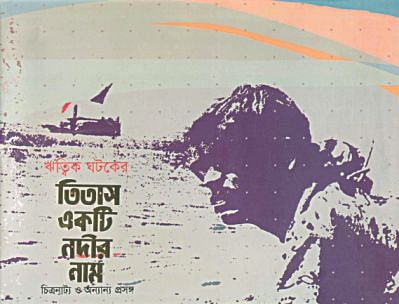The story behind a movie

Titas is a small, little known river flowing by the district of Brahmanbaria in Bangladesh. Titas Ekti Nadir Naam (A River Named Titas) is the name of the epic novel composed by Advaita Mallabarmana, depicting the lives of the Malo fishing community living by this river. It evokes the title of a famous Bangladeshi film made by Ritwik Ghatak, one of the greatest personalities in Bengali cinema. Ritwik with his twin sister Prateeti Devi was born in Dhaka in 1925 (parental home in Pabna), grew up in Rajshahi and left East Bengal in 1947. This part of Bengal always filled his heart and pulled him incessantly towards its greenery, rivers, sands, songs and people. This, together with the persuasion of the young cinema-producer Habibur Rahman Khan, brought him to Bangladesh after the country's liberation. The objective was to make a movie based on Advaita's epic novel. Ritwik came to Dhaka in 1972 and during the editing of the movie fell ill owing to tuberculosis in 1973. The editing was then completed by Bashir Ahmed. Now the film is considered one of the world's classics. In 2012 it is the 40th anniversary of the making of this great film.
The 40th anniversary of this classic movie has been celebrated with the publication of Ritwik Ghataker Titas Ekti Nadir Naam: Chitronatya O Onyanya Proshango. This 222-page album-size book is edited by Monis Rafiq and published by Impress Telefilm Ltd. With a preface by filmmaker Syed Salahuddin Zaki, the work contains three interviews, eight essays, fifteen reminiscences, three newspaper articles, and two write-ups on today's Titas. In addition, it has a script of the movie, prepared by Parthib Rashed, assistant editor of this publication. With Selim Ahmed's cover design and graphics and contents from writers who can authoritatively talk about the movie and its director, it is an impressive publication.
This book is the story of the endeavours that went into the making of this movie and from it readers can come to know of various interesting facts related to the movie and can have some insight into Ritwik's work. The interviews and reminiscences are by individuals who had been very close to Ritwik during the making of this movie. The first interview is Ritwik's and the reminiscences also include his write-up about Titas Ekti Nadir Naam. There are write-ups from producer Habibur Rahman Khan, actor Prabir Mitra, actor Sirajul Islam, actor Khalilullah Khan, actor Abul Hayat, advisor Syed Hasan Imam, chief assistant director Fakhrul Hasan Bairagi, assistant director A J Minto, Tandra Islam (cameraman Baby Islam's wife) and others who have shared their thoughts about the filmmaker in profound ways.
The write-ups of Golam Sarwar, Sanjib Datta and Alamgir Kabir have been taken from newspapers, the latter two in English. Datta's write-up in The Bangladesh Observer of 10 August 1973 called this movie 'A Raw Masterpiece' because Ritwik's sudden illness at the last stage forced him to be absent from 'the most important part of finally editing the film and presenting in its intrinsic worth'. On the other hand, Kabir's article in the issue of Holiday of 5 August 1973 is a scathing criticism of the film.
In their essays Pralay Sur, Mahbub Alam, Moinuddin Khaled, Dr Mohammad Jahangir Hossain, Sajedul Awal and Ahmad Mazhar have brought out various positive aspects of the movie. On the other hand, Masihuddin Shaker has pointed to theatricalism and sentimentality and Gautam Bhadra to the fallacies in social analysis and diversion from the novel.
There is a 49-page album of still photographs taken by Sunil Amin during the shooting of the movie, which has made this a very eye-catching book. The editor has been liberal in selecting write-ups for this volume; so write-ups that have appreciated as well as criticized Ritwik and the movie have been included in the compilation. Therefore, readers are presented with various aspects of the film with all its cinematic charms and weaknesses.
Though Alamgir Kabir was harsh about Titas Ekti Nadir Naam, Sanjib Datta soberly hoped that with proper editing the 'stock of raw matter . . . would make for one of the best films done in the whole of the subcontinent'. Dr Mohammad Jahangir Hossain, former Director General of Bangladesh Film Archive, informs us that in 2010 this movie was screened at the Cannes Film Festival, the only cinema ever from our country to be accorded that honour. Ritwik and his film Titas are acquainting people around the world know about Bangladesh. This book is a befitting and long-lasting tribute to the most famous Bangladeshi film and to a great movie maker born in Bangladesh.

 For all latest news, follow The Daily Star's Google News channel.
For all latest news, follow The Daily Star's Google News channel. 



Comments